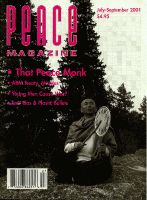
Peace Magazine Jul-Sep 2001, page 11. Some rights reserved.
Search for other articles by Carolyn Bassett here
I never did see the infamous wall. The closest I came was to choke on the tear gas that permeated the centre of the city. But that does not mean that my participation in Quebec City was not affected by the security perimeter.
It seemed that everybody who attended the alternative events in Quebec City had a story to tell about their experience with official violence, harassment and intimidation. One guy described how frightened he was to enter the city on Friday morning on a road rimmed by a corridor of Sureté du Québec officers. Throughout the day on Friday, the teach-ins were interrupted for reports of tear gassing at the wall. Similar reports, complete with graphic footage, featured prominently on the television news both Friday and Saturday night.
Some people told stories of witnessing forms of terror that we have seldom seen in Canada. One friend described how intimidated she was by police officers, in full riot gear, marching in columns six wide by 25 or more deep outside the security perimeter. Most disturbingly, part-way through the march on Saturday came the rumor, later largely confirmed, that activist Jaggi Singh had been arrested in a manner much like a "disappearance."
This intense, pervasive and multi-faceted violence permeated everything that I did and thought about in Quebec. It made me feel, in turn, angry, fearful, disempowered. I was there as a staff-person of a peace organization, hoping to make connections with economic and social justice groups and to highlight the links between militarism and corporate globalization. But my original goal was displaced by my preoccupation with the wall and with our reaction to it. I have no doubt that this was a deliberate reminder of the depth and breadth of coercive resources available to the state.
by mid-Friday, all eyes were focused on the security perimeter. Efforts to draw attention to the injustice contained in the FTAA negotiations by protesting at the security perimeter led the mainstream media to largely ignore the content of the protest (and the summit itself, for that matter) and to focus on the spectacle. The news of the summit became reports of the protests and arrests.The wall was real-and yet, it was symbolic. The wall literally kept us away from the negotiations. But it allowed us to forget that even if the wall had not been there, we still would have been excluded.
The wall also turned our attention from our own spaces, the People's Summit and the SALAMI teach-in and the artists' café and so on. These were the venues where we could discuss what I believe has to remain our agenda - to address the systematic economic, social and cultural exclusion of the majority of the people in the hemisphere from the benefits of economic globalization and the violence that keeps these structures in place. Is attempting to dismantle the wall a legitimate form of nonviolence even when it will inevitably provoke a violent response from the state and from some protesters in turn? Should one turn left during the march and go to the wall or right to follow the official route? Such questions overshadowed important debates about tactics in the broader struggle for justice and democracy.
Social ExclusionSocial exclusion is the core of the structural violence that affects millions in the hemisphere on a daily basis. The third draft of Alternatives for the Americas, prepared by the Hemispheric Social Alliance for the People's Summit, highlighted precisely these concerns when it argued that "we must find ways to take creative advantage of globalization and not passively submit to it. ... We cannot remain on the sidelines but must claim our role as valid stakeholders in the globalization dialogue. We must refuse to accept the current neo-liberal form of globalization as irreversible. We must not only reduce its negative consequences, but put forward a positive alternative." I believe that we need to retain our focus on the social exclusion that is embodied in the content and process of the FTAA as it is currently constituted. The violence at the wall-of the wall-was exciting but it too was spectacle.
Carolyn Bassett is the coodinator of the Canadian Peace Alliance.

Peace Magazine Jul-Sep 2001, page 11. Some rights reserved.
Search for other articles by Carolyn Bassett here